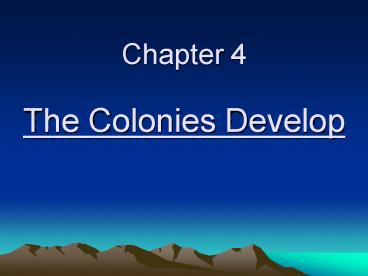Chapter 4 The Colonies Develop - PowerPoint PPT Presentation
1 / 21
Title:
Chapter 4 The Colonies Develop
Description:
To meet the labor need, planters used enslaved Africans. African pop. ... Planters became wealthy off $$ from crops. They called themselves the Planter Class ... – PowerPoint PPT presentation
Number of Views:548
Avg rating:3.0/5.0
Title: Chapter 4 The Colonies Develop
1
Chapter 4The Colonies Develop
2
Where would you settle?
THINK about this
- Would you settle on a farm? Why?
- Would you settle in a town? Why?
- How would you make a living?
3
Regions Develop
- By 1750, more than 1 million settlers called the
English colonies home. - The colonies formed into 3 regions
- New England Colonies
- Middle Colonies
- Southern Colonies
- WHY? Different climate, resources and people in
each region made them different.
4
The New England Colonies
- Made up of
- Massachusetts (including Maine)
- New Hampshire
- Rhode Island
- Connecticut
Quick Look
5
A picture of Boston one of the largest cities
at the time
6
The New England Colonies Economy
- Rocky soil and a short growing season little
farming. - Subsistence farming produced just enough food
for themselves little to trade. - Atlantic Ocean provided a fishing/whaling
industry. - New Englands forests provided timber / lumber
to build boats to fish.
7
The New England Colonies Trade
- Triangular Trade trading route with 3 stops.
(makes a triangle) - Slaves, rum, spices, tobacco, rice, indigo, gold,
sugar molasses
EXAMPLE ship leaves New England with rum.
Stopped in Africa, traded rum for slaves. Stopped
in West Indies, traded slaves for sugar
molasses. Came home with sugar molasses.
- Navigation Acts laws passed by England to
ensure they make money from trading.
EXAMPLE taxing any goods not shipped to
England. All shipping to be done in English
ships (make ).
8
Triangular Trade
9
The New England Colonies Society
- Few slaves in New England. WHY? Not many farms
where slaves could work. - Some slaves did work as house servants, cooks.
- Blacks in New England could buy their way to
freedom. New England had more free
blacks than any other
region.
- Puritan religion began to decrease (fade out)
- WHY? Increasing competition from other religions
- Cared more about business and
than religion.
10
The Middle Colonies
- Made up of
- New York
- Pennsylvania
- New Jersey
- Delaware
Quick Look
11
The Middle Colonies Economy
- Diverse population immigrants from all over
Europe came to take advantage of productive land. - LONG growing season LOTS of farming.
- Grew cash crops crops raised sold for money.
- Produced so much bread / grain products, they
became known as the Breadbasket Colonies.
12
The Middle Colonies Cities
- Harbors rivers along the coast were ideal cites
for BIG cities to form. - New York City
- Philadelphia (fastest growing city in colonies)
- WHY? Use water for transportation/trade routes
- Had diversity (variety) of different people
EXAMPLE French, Swedish, Welsh, German, Dutch,
English, Scots-Irish, African
13
The Middle Colonies Religion/Society
- There were many different religions because of
the many different people. - People in Middle Colonies were very tolerant
(accepting) of different religions.
- Quakers in Pennsylvania honored religious
tolerance (letting you believe what you wanted). - Quakers believed all people were equal
- Did not believe in slavery
- Slavery did exist in the Middle Colonies, about
7 of the population were enslaved. Many worked
in big cities (New York)
14
The Southern Colonies
- Made up of
- Maryland
- Virginia
- North Carolina
- South Carolina
- Georgia
Quick Look
15
The Southern Colonies Economy
- Year-round growing season rice, tobacco,
indigo crops. - Needed much labor to produce these cash crops
(slaves) - Plantations formed - large farm that raises cash
crops - Tried to force Native Americans to work, but they
caught disease. To meet the labor need, planters
used enslaved Africans. - African pop. grew in South. 85 lived in Southern
Colonies
16
The Southern Colonies Economy Slavery
- Slave intensive crops rice indigo
- Indigo - a plant that makes a deep blue dye.
- Rice required back-breaking labor skill. Many
West Africans had these skills - Planters became wealthy off from crops. They
called themselves the Planter Class - They would buy more slaves with
- their money to make more money.
17
(No Transcript)
18
Life As A Slave
- Overseers were men hired by the slave owner to
watch over and direct the work of slaves. - Work 15 hours a day, lived in small one-room
houses, little food. - Africans preserved many customs dances, music,
stories and even religion - Strong family values
19
Identify the 13 Colonies
New York
New Hampshire
Pennsylvania
Massachusetts
Rhode Island
Connecticut
New Jersey
Virginia
Delaware
Maryland
North Carolina
South Carolina
Georgia
20
Natural border
- What natural border lies west
of the thirteen colonies
that prevented settlers
from moving
too far west?
Appalachian Mountains - known as the Backcountry
21
Visual Summary
NEW ENGLAND COMMERCE AND RELIGION New England
was distinguished by its small farming towns and
profitable fishing and trade.
MIDDLE COLONIES FARMS AND CITIES Middle Colony
farms produced large cash crops that fueled trade
in its coastal cities.
THE SOUTHERN COLONIES PLANTATIONS AND
SLAVERY The Souths plantation economy and large
number of enslaved Africans made it different
from the other regions.
THE BACKCOUNTRY The Backcountry was distant from
the denser coastal populations, so settlers there
developed an independent and rugged way of life.
Back toTransparencies































